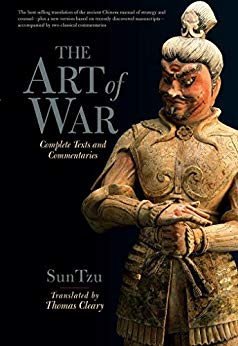

This article is an excerpt from the Shortform summary of "The Art of War" by Sun Tzu. Shortform has the world's best summaries of books you should be reading.
Like this article? Sign up for a free trial here .
Was the transition between the Sui and Tang dynasties smooth? What can we learn from how the Tang ruler wiped out rebel Sui armies?
We’ll cover the fight between the Sui and Tang dynasties and what the Tang army can teach us.
Sui and Tang Dynasties: Knowing When to Fight
At the beginning of the new Tang dynasty (618 to 905 C.E.), the founding ruler wanted to wipe out rebel armies from the former Sui dynasty still on the attack. When the ruler and a fellow warrior scouted the rebel army, they saw they were at a disadvantage sizewise. The warrior cautioned that attacking the rebels head on would be impossible. He suggested fortifying their position to tire them out and deplete their resources. The rebels expended much energy to instigate a battle with the Tang and ran out of food by nightfall. When they started to retreat, the Tang army followed and overpowered them.
Lessons from the Battle of Sui and Tang dynasties
What can this story about the Sui and Tang dynasties teach us? If strategic, psychological warfare does not lead to an early solution, then you may be called upon to physically attack enemy forces. Attacks should be on enemy forces only, not territories, cities, or civilians.
Wearing the Enemy Down
In the anecdote about the Sui and Tang dynasties, the Tang wore the Sui down. In addition to manipulating a strong enemy into carelessness, forcing the enemy to exert energy will create opportunities of advantage for you.
Wearing the Enemy Down
In addition to manipulating a strong enemy into carelessness, forcing the enemy to exert energy will create opportunities of advantage for you.
Strategize your efforts so they are geared toward controlling your opponent’s momentum. These tactics include surprise attacks, retreating when they advance, advancing when they retreat, and maneuvering them in different directions.
For example, you might strike a certain portion of the enemy’s forces to push them down a particular path in defense. When their energy shifts to take up this defense, switch your assault to the enemy troops in the opposite direction. Switching attack positions forces your opponent’s defense to hustle down another path to defend against your advance.
Moving them back and forth by forcing them to react to conflict, rather than allowing them to initiate conflict, will keep them on their toes and tire them out, as in the story of the Sui and Tang dynasties.
In addition to manipulating a strong enemy into carelessness, forcing the enemy to exert energy will create opportunities of advantage for you.
Strategize your efforts so they are geared toward controlling your opponent’s momentum. These tactics include surprise attacks, retreating when they advance, advancing when they retreat, and maneuvering them in different directions.
For example, you might strike a certain portion of the enemy’s forces to push them down a particular path in defense. When their energy shifts to take up this defense, switch your assault to the enemy troops in the opposite direction. Switching attack positions forces your opponent’s defense to hustle down another path to defend against your advance.
As in the story of the Sui and Tang dynasties, moving the enemy back and forth by forcing them to react to conflict, rather than allowing them to initiate conflict, will keep them on their toes and tire them out.
Preparation Is Key
Prepare ahead of time to avoid catastrophe in the field. Sun Tzu says six months are required to prepare the materials for an attack, including weapons and shelters, to avoid malfunctions and casualties. Don’t rush into battle without first ensuring that you’re adequately prepared. If you fight from a place of anger and don’t take time to prepare, you will be sending your troops to their deaths.
A strategic siege is one where your forces are still strong, your resources still ample, and your casualties are nil. This was the case for the Tang in the battle story of the Sui and Tang dynasties.
The Rules for Approaching Enemy Forces
In the story of the Sui and Tang dynasties, the Sui dynasty force was much larger than the Tang. But if all traits are equal between you and your enemy, there are rules for how to proceed.
If you have ten times the troops, you should surround the enemy.
- A large differential is needed if you are to enclose them without gaps in the formation.
If your numbers are not large enough to attack, such as only five times larger than those of the enemy, divide your troops into groups.
- Use several groups to broach an attack, and keep a few back to bar against surprise attacks and exploit any enemy weaknesses you observe as the attack progresses.
If you are only slightly larger, such as a two-to-one ratio, divide your troops into two groups.
- Use one group to draw out the opponent, and use the other to attack them unexpectedly.
If you are equal in size and ability, deploy strategies to avoid direct combat.
- Use strategies of division to disrupt the enemy’s power, then engage in ambushes and surprise attacks.
- If this strategy is not possible, go on the defensive and stand your ground.
- Don’t get pulled into battle if you are not sure of victory.
If you are smaller or weaker, avoid conflict and flee.
- Again, engaging in battle without the assurance of victory is a foolish strategy.
- After retreating, build up your defenses and see to the nourishment of the troops.
- Wait for a gap in the enemy’s strategy or for the enemy to relax, then strike.
Understanding Appropriate Strategy
Like the Tang in the Sui and Tang dynasties battle, you need the right strategy. The strategy of your troops must be malleable based on circumstances. If you try to control the troops only after conflict has begun, you will be thwarted or outmaneuvered.
If you know your strengths and abilities and measure them as effective against your opponent, you can enter conflict prepared for anything. If you only know your strength and not your opponent’s, you will enter conflict blindly.
- When you understand the essence of your enemy, you will know how to approach battle against them.
- When you understand your essence, you will know where you are vulnerable and how to mitigate impact.
Learn from the Tang in this battle story of the Sui and Tang dynasties.
———End of Preview———

Like what you just read? Read the rest of the world's best summary of "The Art of War" at Shortform . Learn the book's critical concepts in 20 minutes or less .
Here's what you'll find in our full The Art of War summary :
- How to mislead your enemies to win the war
- Classic examples from Chinese history to illustrate Sun Tzu's strategies
- How to use spies to gather information and defeat your opponents





